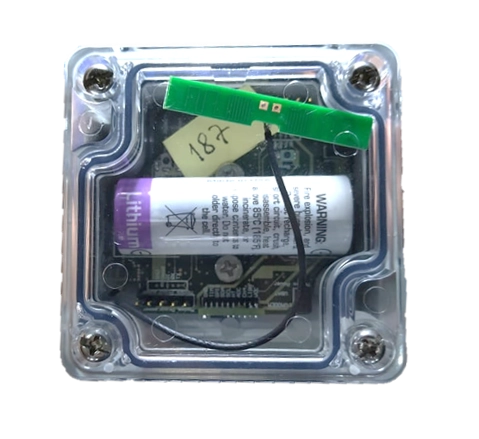The goal of PPS5 is to conceptualize, build and implement a Living Lab of cyber-physical systems focused on Energy, which will demonstrate the potential of the technology developed in the other PPSs of the project. Based on this goal, the devices designed and developed in the scope of PPS3 (figure 1) were submitted to tests in scenarios with conditions similar to real ones, appropriate for each of the use cases.

Figure 1- Developed device
The devices used in all tests share the same base architecture, but may differ in the quality and quantity of sensors. The base architecture has a low-power microcontroller, an NB-IoT communication modem, a 3V battery, and a set of base sensors, namely for measuring temperature, humidity, brightness, and vibrations. Depending on the use case, other more specific sensors can be added to the system, for example: (i) flood sensor, for the use case VHV Underground Cable Joint Bay Monitoring; (ii) magnetic sensor, for the use case OHL & Telecommunication Towers Monitoring; and (iii) methane/gas sensor, for the use case Intrusion and risk assessment in capillary natural gas assets.
So far, at least one deployment per use case has been done with the base architecture. Laboratory tests were also conducted to evaluate the behavior of the device under conditions of electromagnetic interference and electrical discharges, since these are relevant, especially for the first two use cases mentioned above.
Use cases
Figure 2- Deployment conditions for use case 1
VHV Underground Cable Joint Bay Monitoring
Monitoring variables, such as water ingress, access cover integrity, and temperature, in very high voltage underground cable splicing compartments. Figure 2 shows the deployment of the devices at an active site, which allowed us to validate their operation under real installation conditions.
OHL & Telecommunication Towers Monitoring
Gathering information to help determine the structural degradation of power distribution towers, namely by measuring acceleration (tower vibration) and wind speed. Additional information such as temperature, humidity, and electromagnetic field variation will also be collected. Figure 3 shows the deployment of the devices on a deactivated tower, which allowed us to validate their operation under conditions similar to real ones. The influence of the missing variable, the electromagnetic field, was explored in laboratory tests for safety reasons.
Figure 3- Deployment condition for use case 2
Figure 4- Deployment Conditions for Use Case 3
Intrusion and risk assessment in capillary natural gas assets
Monitoring and detection of CH4 leaks, one of the main concerns of a natural gas distribution system. In addition, a mechanism to detect unauthorized access is being developed to improve the levels of protection and safety in the natural gas supply service. Figure 4 shows the deployment of the devices in deactivated locations, allowing you to validate their operation in conditions similar to real ones. Intrusion is detected by the light sensor, and may be aided by the vibration sensor. The response to the missing variable, natural gas, is being studied in the laboratory for safety reasons.
